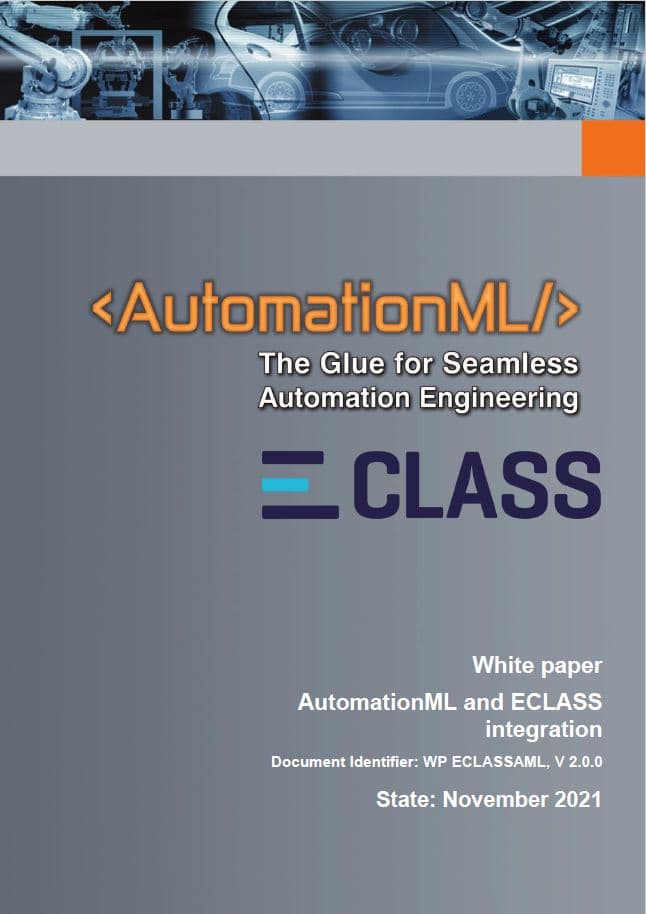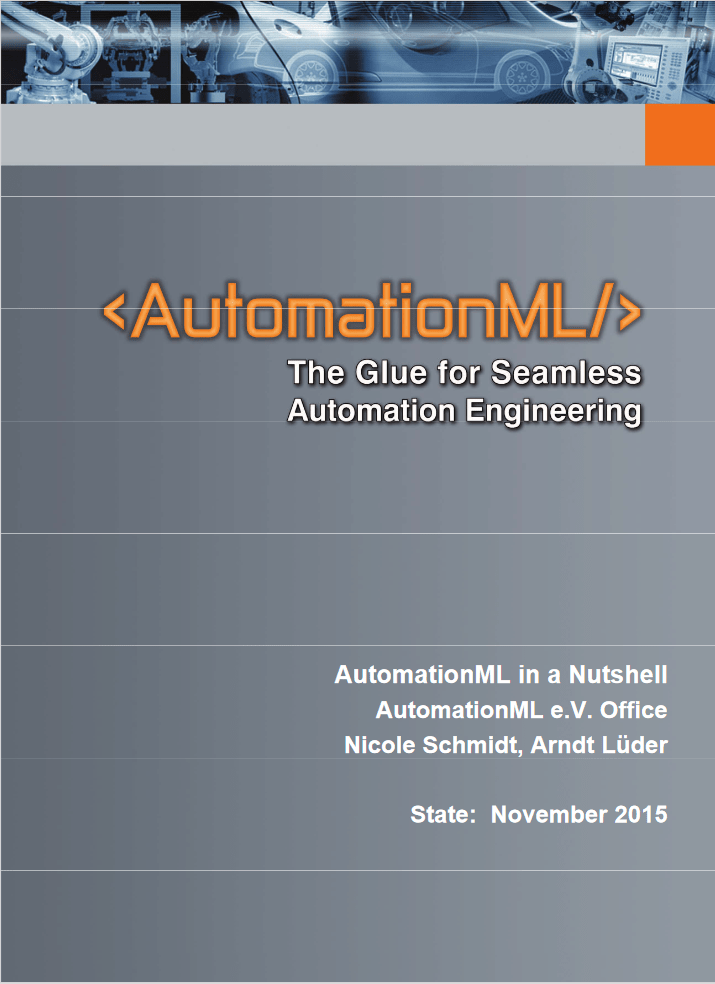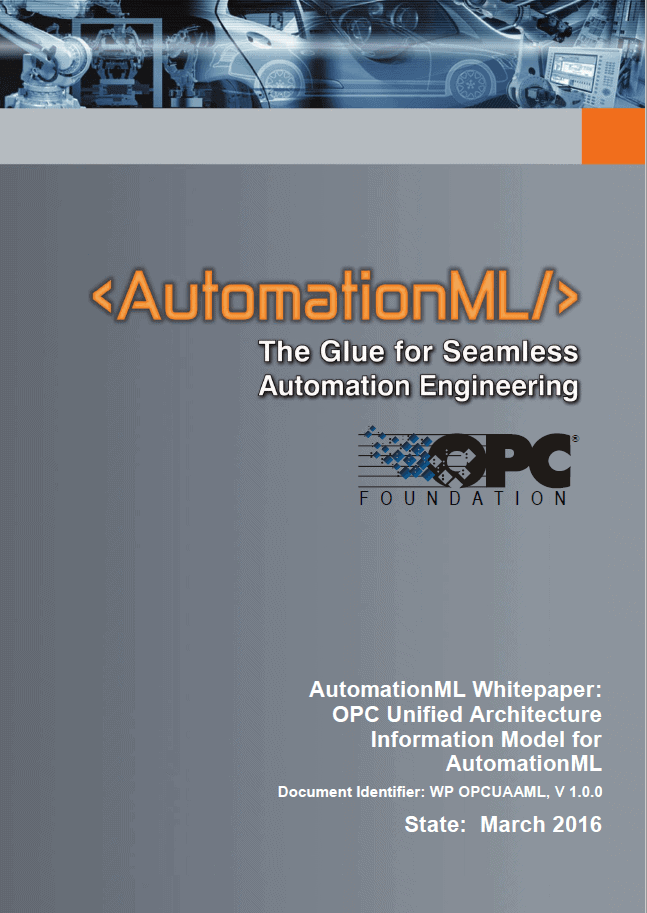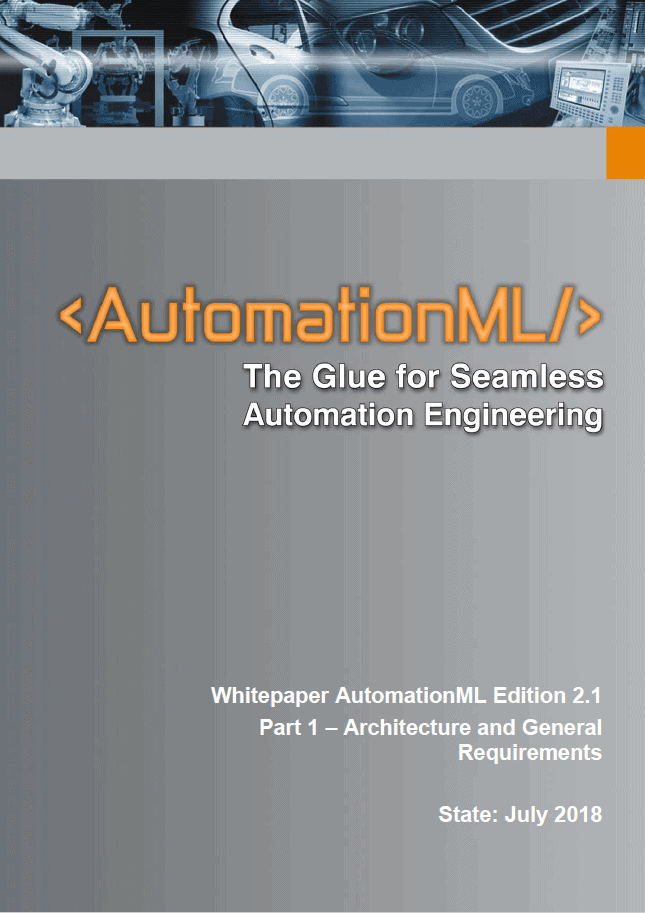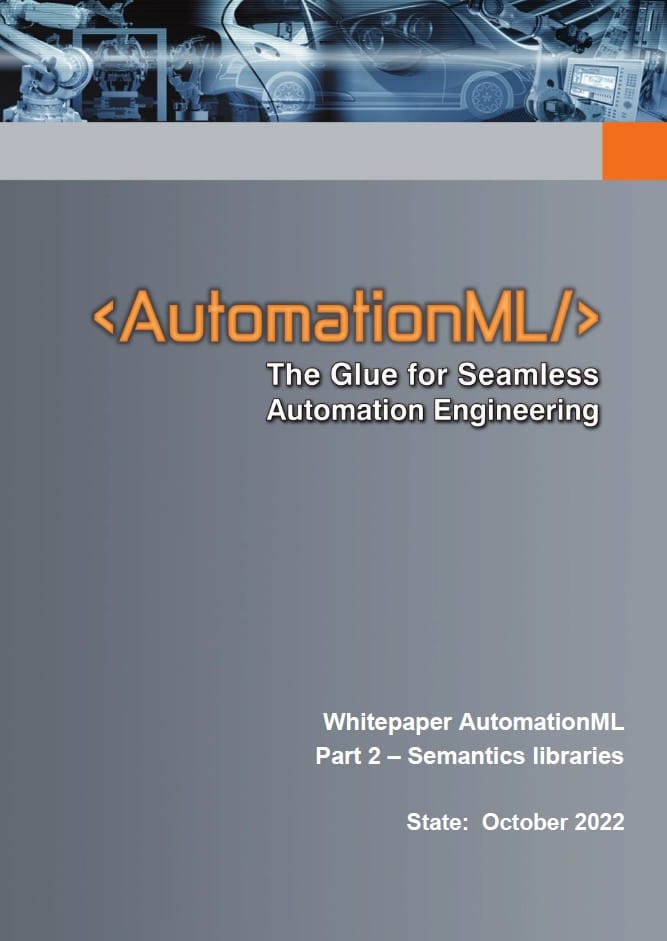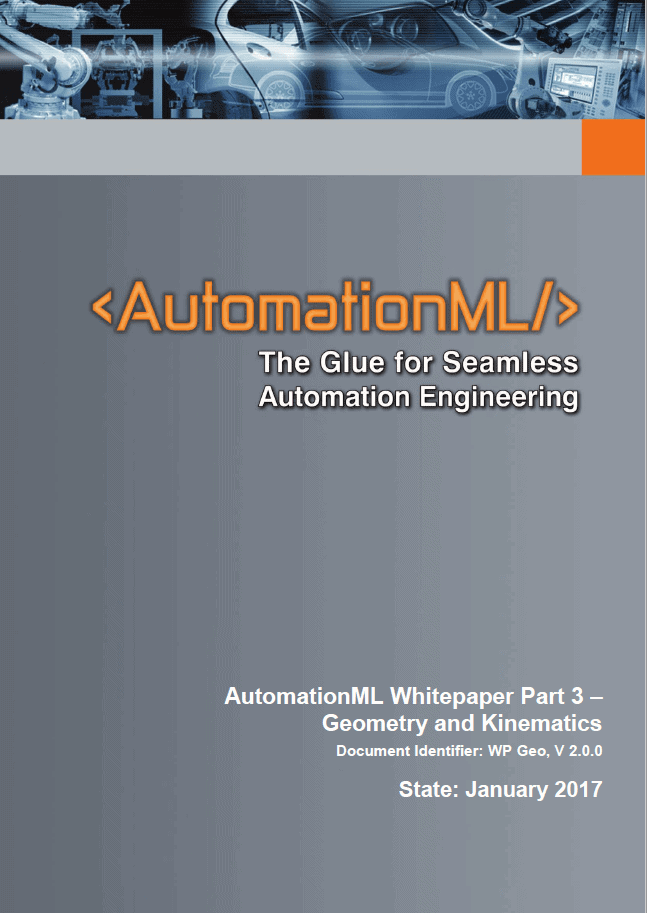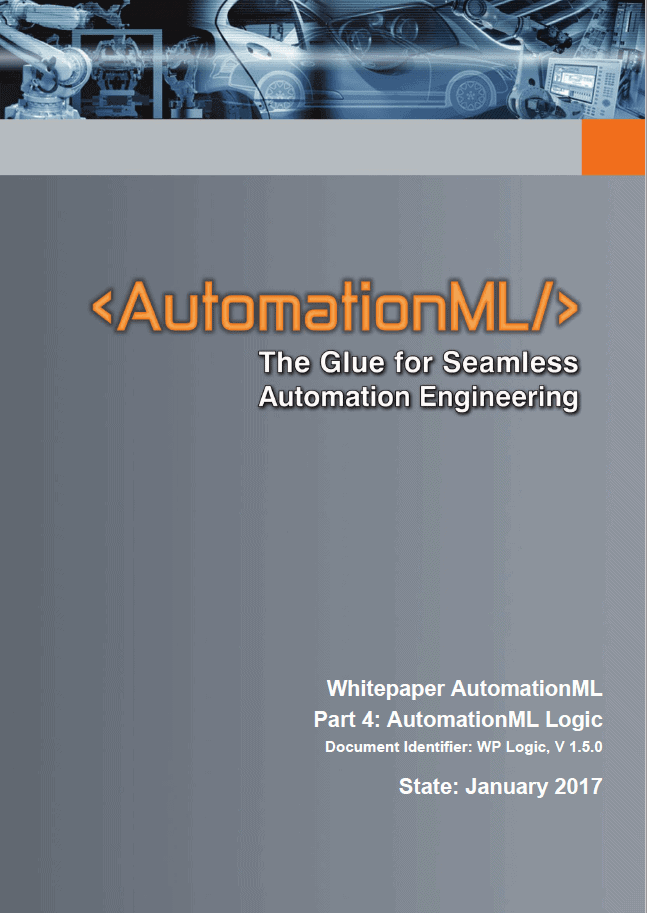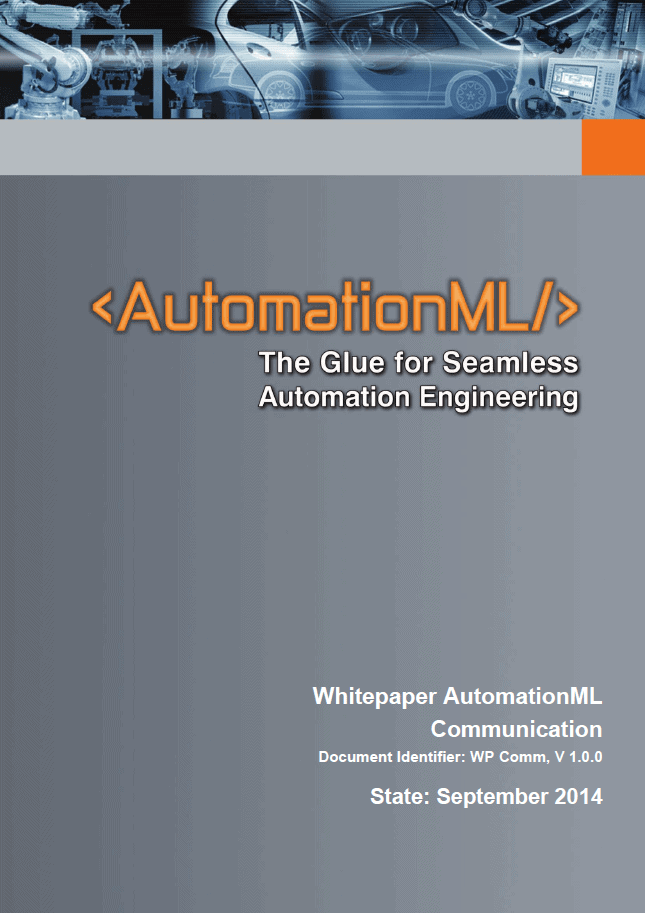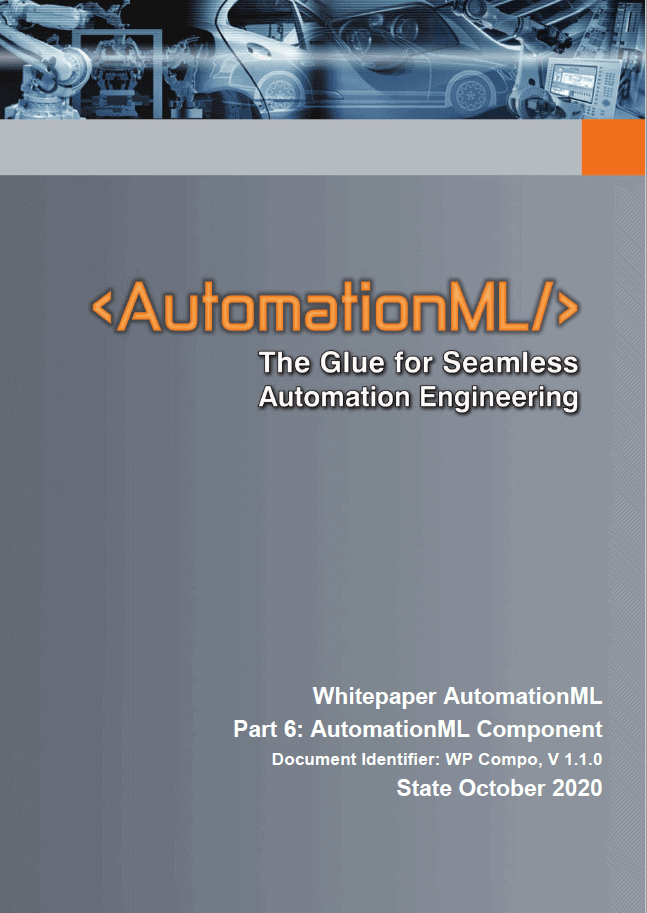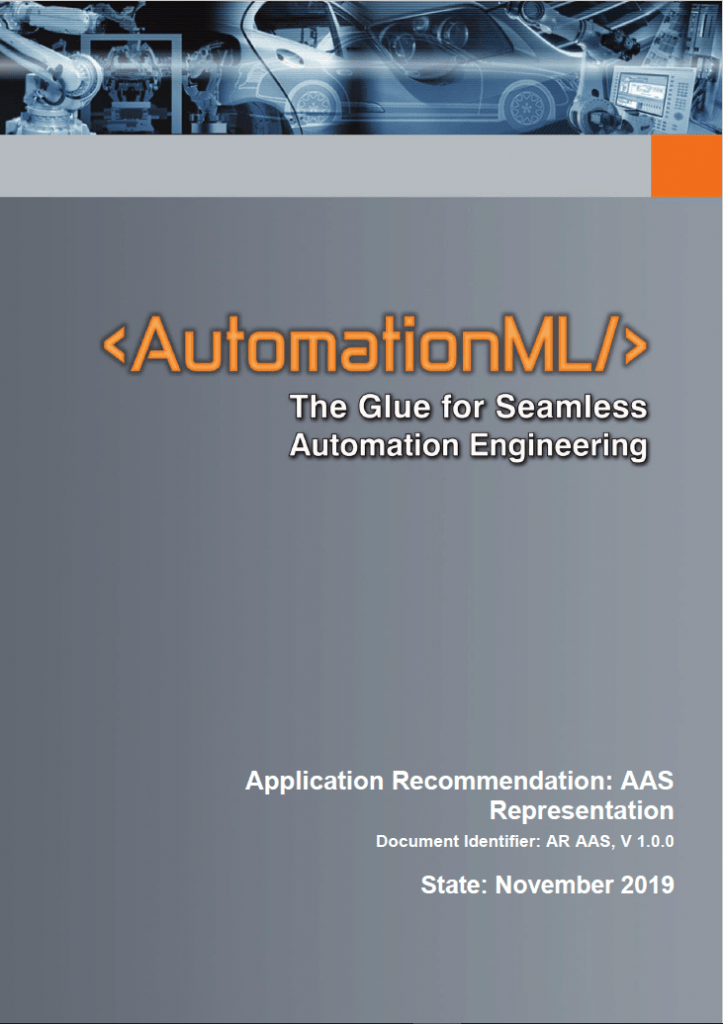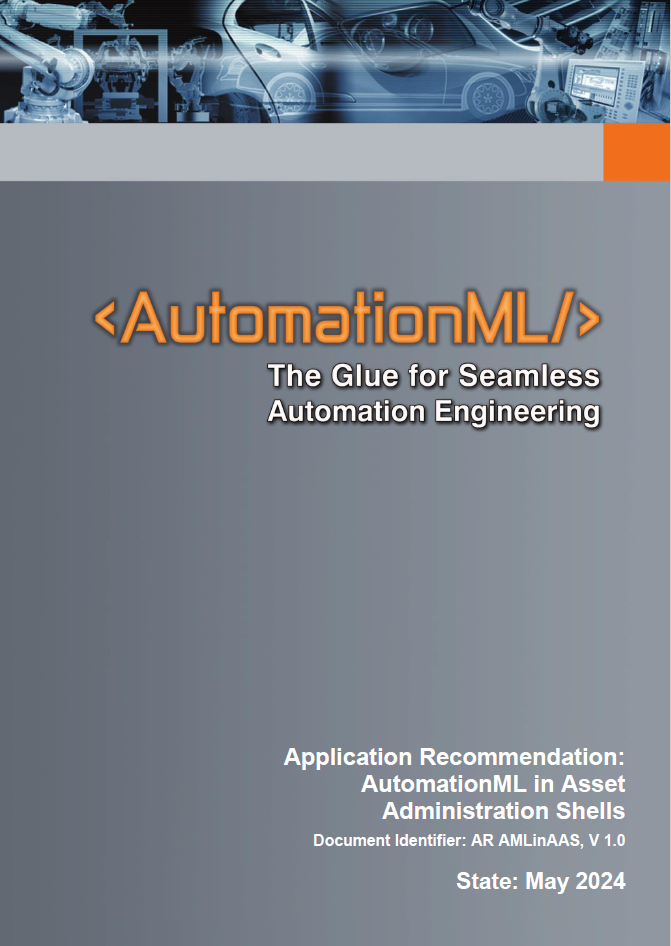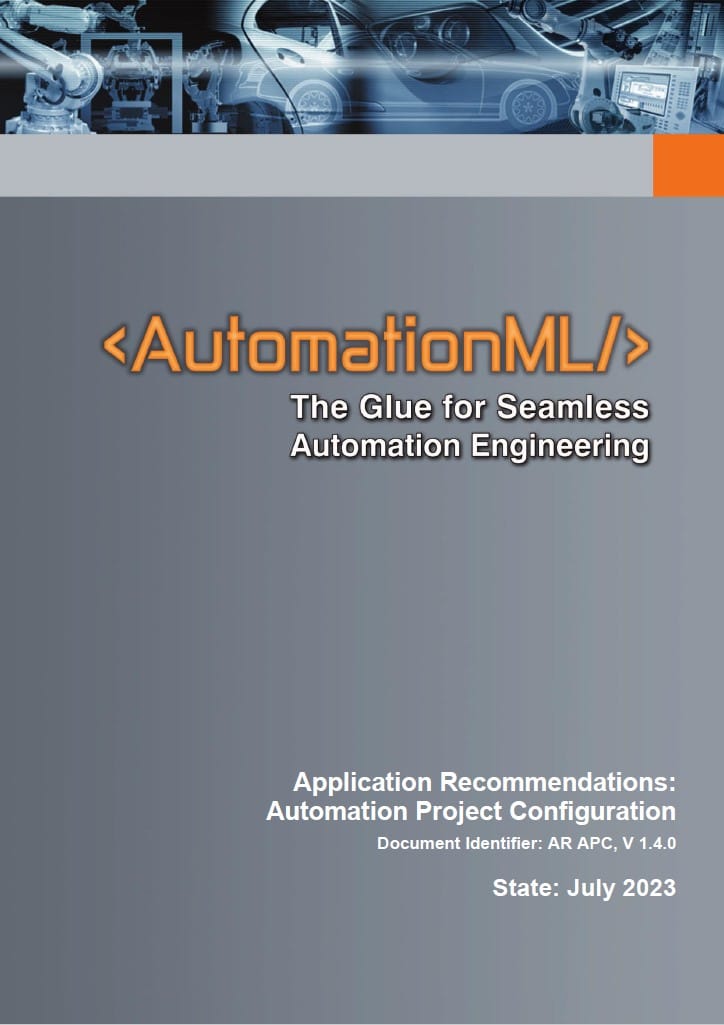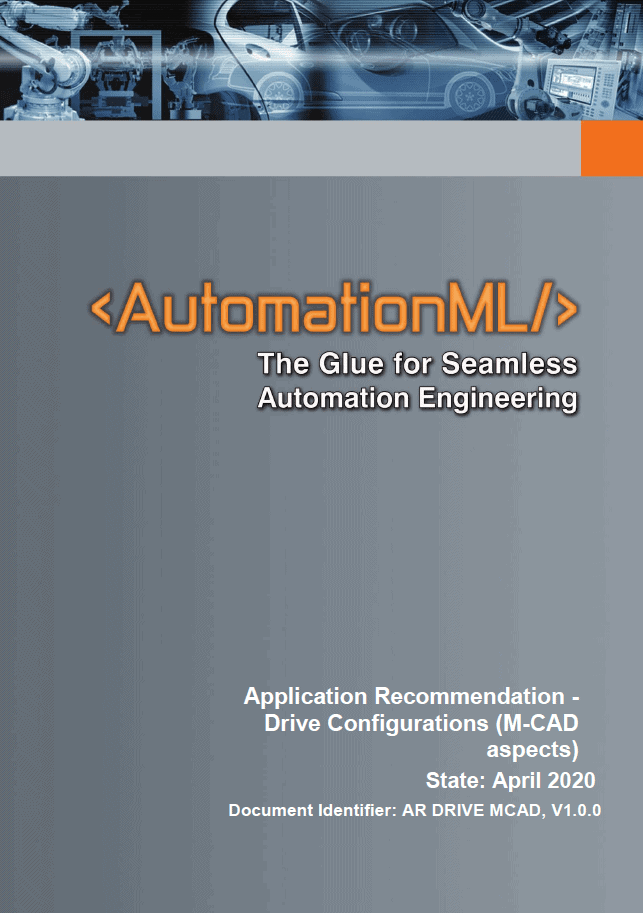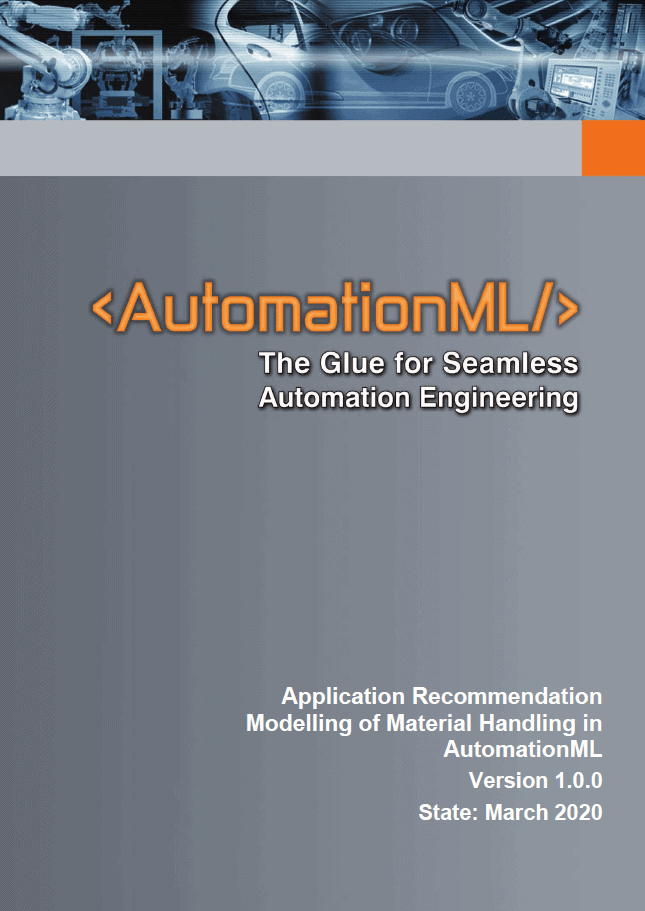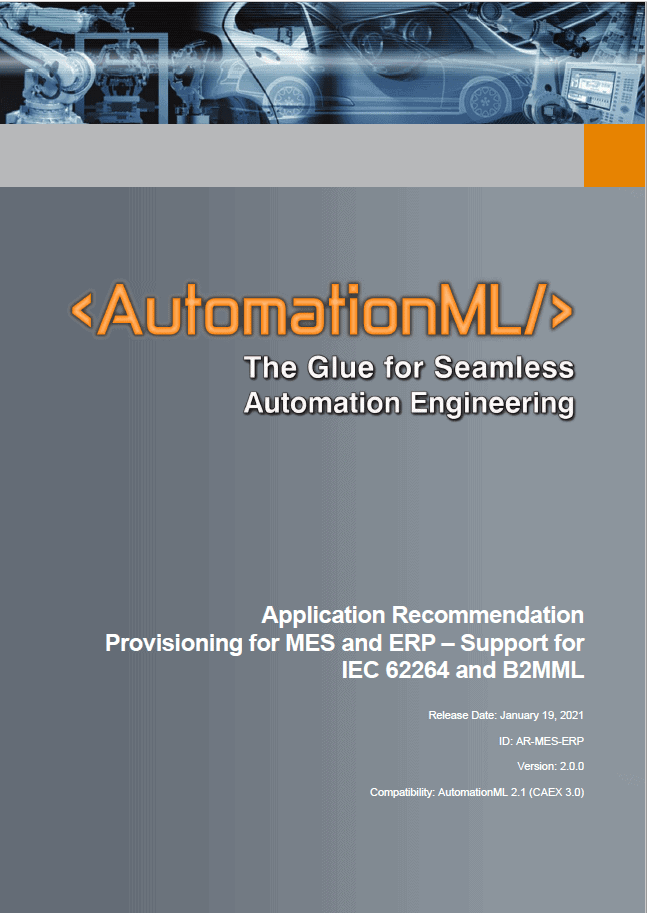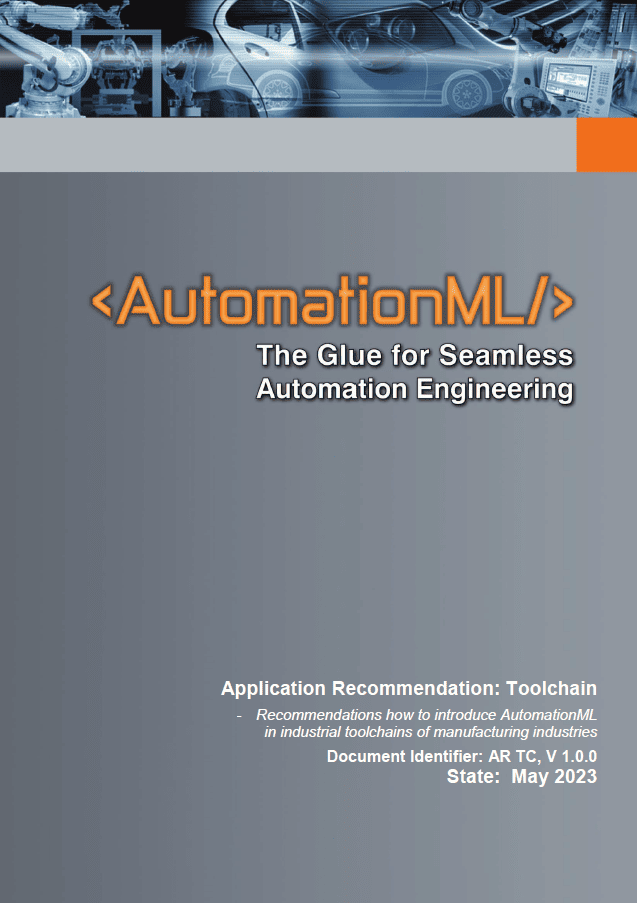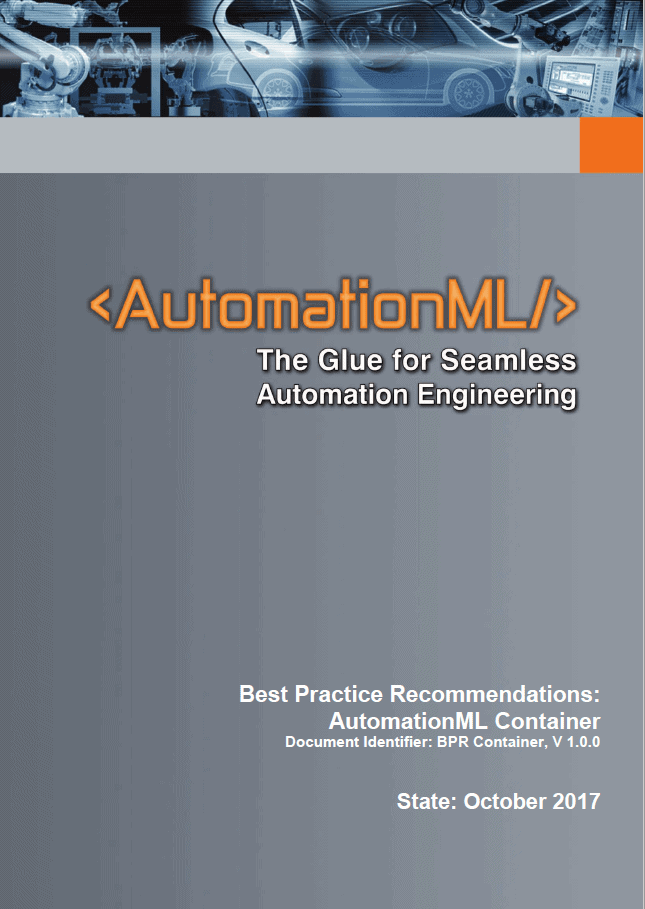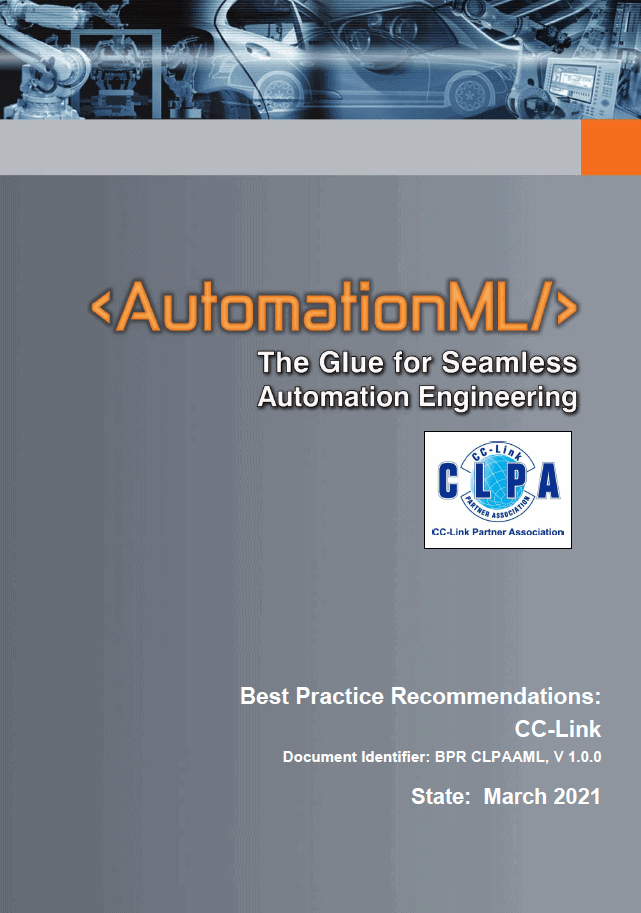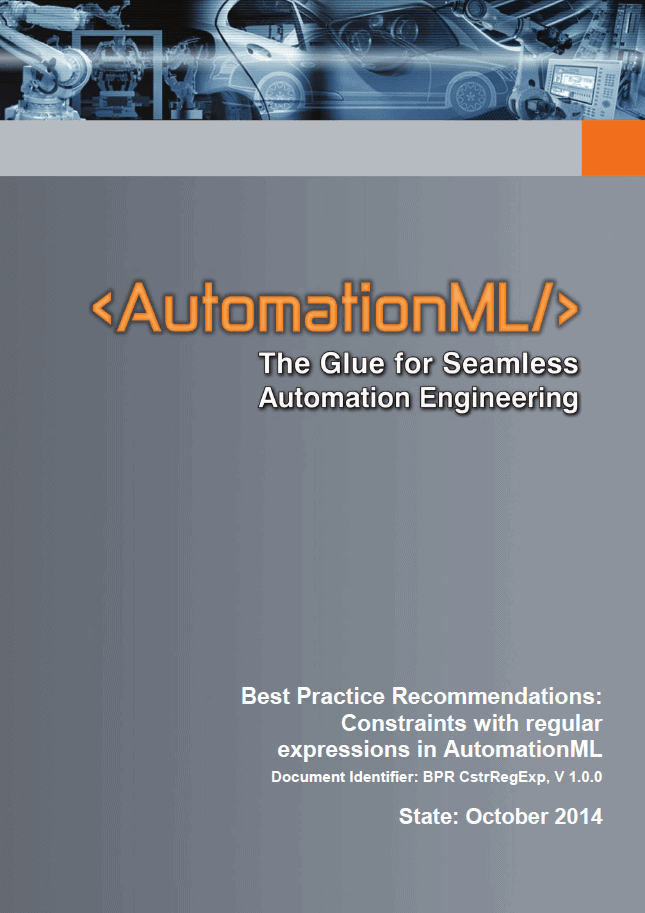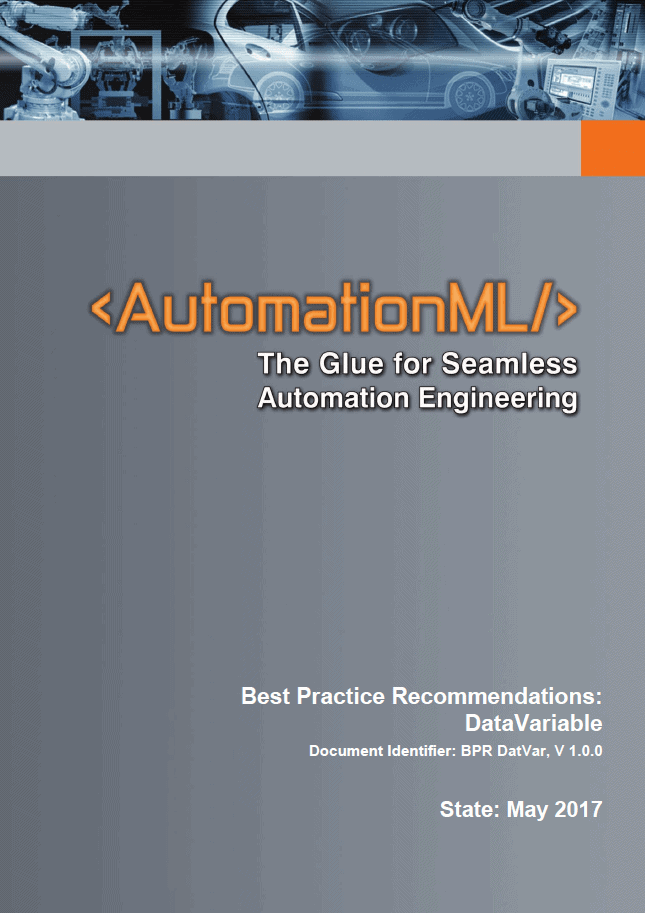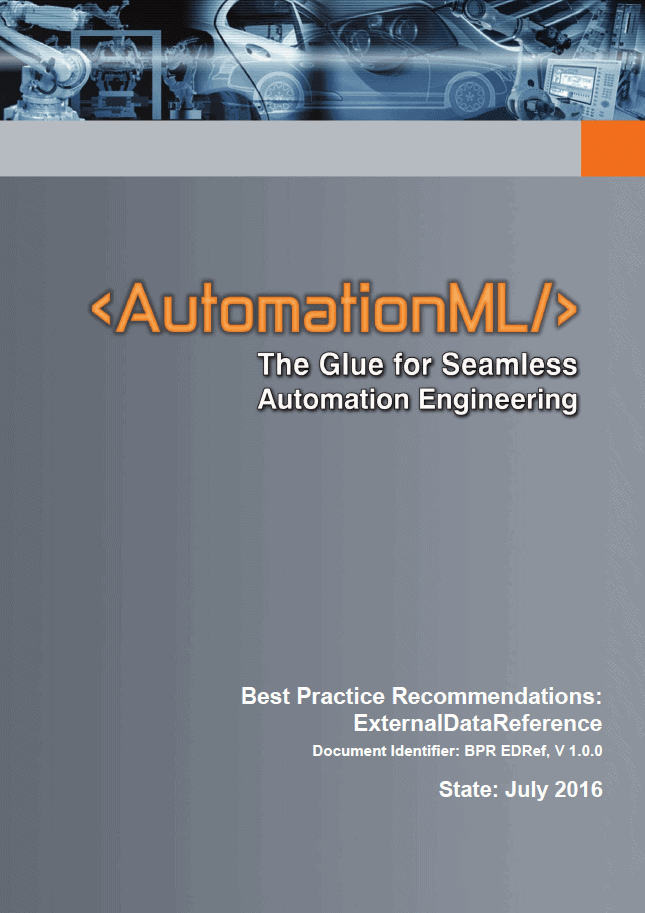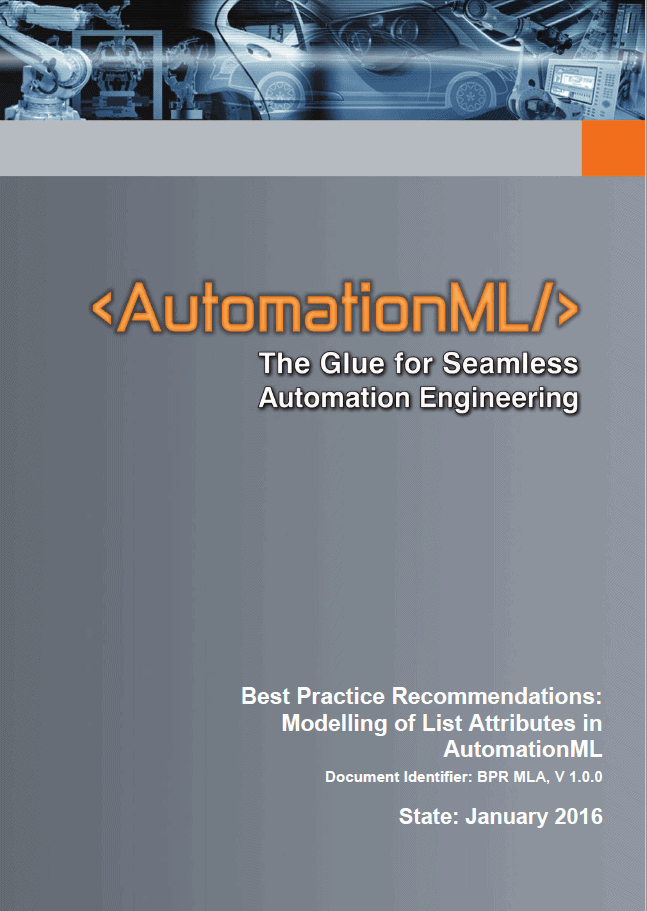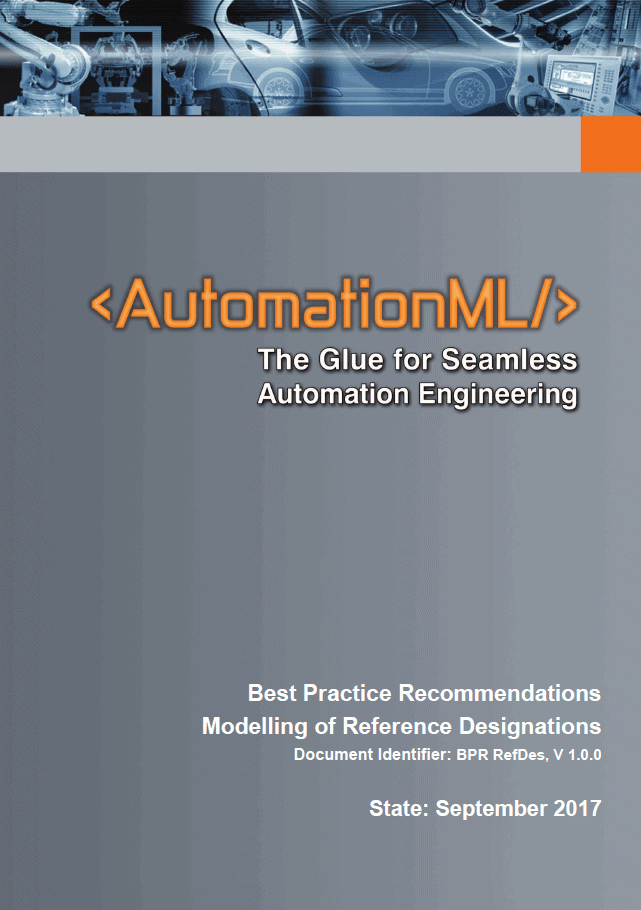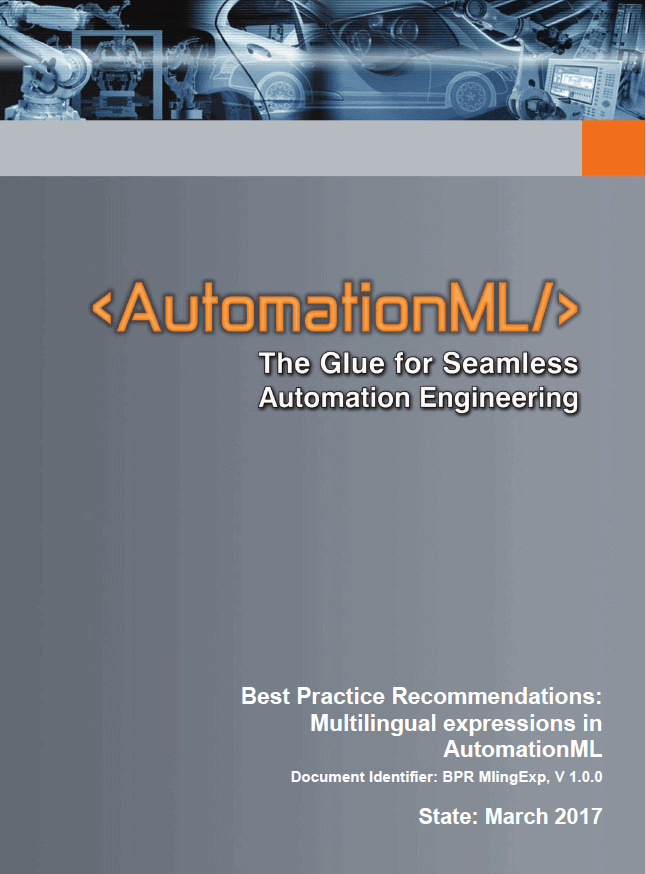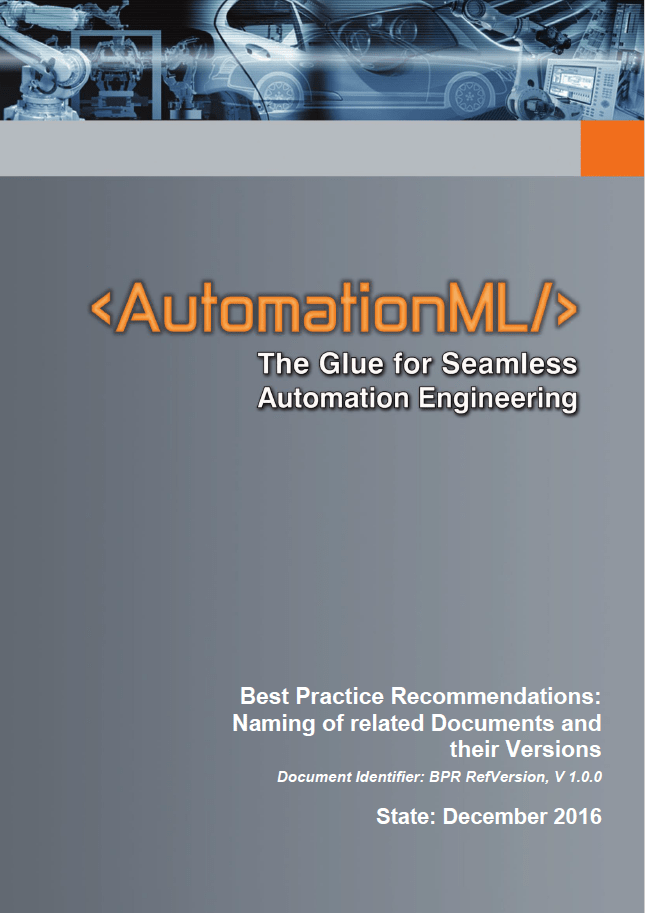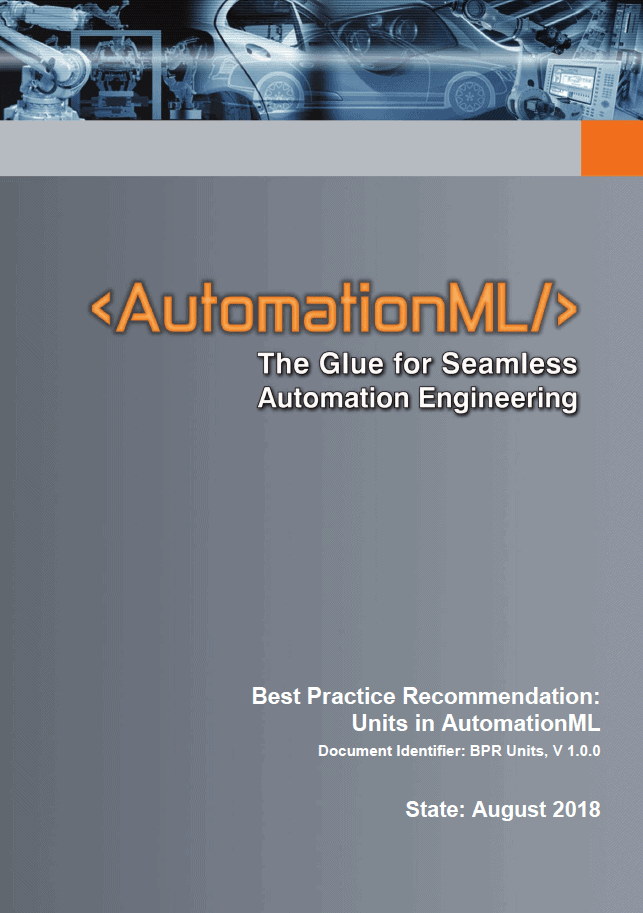Whitepaper
WP – AutomationML and ECLASS integration
Within the industry, several catalogue standards are available defining object and property semantics uniquely. Usually they follow the IEC 61360 standard. One example is the ECLASS catalogue standard. Within this standard a four layer object definition hierarchy with object properties is defined enabling the unique identification of object types like automation device types and its property types like vendor names.
Such catalogue standard will be valuable for the definition of object semantics within a data exchange format. This whitepaper will take up this idea. It will define a methodology how ECLASS and similar catalogues could be applied to define unique data point semantics within AutomationML.
Documents:
- WP AutomationML and ECLASS integration
WP – OPC Unified Architecture Information Model for AutomationML
This whitepaper was created by a joint working group of the OPC Foundation and AutomationML e.V.. It defines an OPC UA Information Model to represent the AutomationML models.
Documents:
- Whitepaper OPCUA for AutomationML
Libraries:
- Topology.aml
WP Part 1 – Architecture and General Requirements
This whitepaper specifies general requirements and the architecture of AutomationML for the modelling of engineering information, which is exchanged between engineering tools for industrial automation and
control systems. Its provisions apply to the export/import applications of related tools.
This whitepaper does not define details of the data exchange procedure or implementation requirements for the import/export tools.
Documents:
- Whitepaper AutomationML Edition 2.1
Libraries:
- AutomationML2.1BaseLibraries.aml
WP Part 2 – Semantics libraries
This whitepaper specifies normative as well as informative AML libraries for the modelling of engineering information for the exchange between engineering tools in the plant automation area by means of AML. Moreover, it presents additional user-defined libraries as an example. Its provisions apply to the export/import applications of related tools.
This part of IEC 62714 does not define details of the data exchange procedure or implementation requirements for the import/export tools.
Documents:
- Whitepaper Part 2 – Semantics libraries
Libraries:
- AutomationMLBMIRoleClassLib_V1.1.0.aml
- AutomationMLCMIRoleClassLib_V1.1.0.aml
- AutomationMLCSRoleClassLib_V2.3.1.aml
- AutomationMLDMIRoleClassLib_V2.4.0.aml
- AutomationMLExtendedRoleClassLib_V2.7.1.aml
- UserDefinedRoleClassLibISA106_V2.0.1.aml
WP Part 3 – Geometry and Kinematics
This part of IEC 62714 specifies the integration of geometry and kinematics information for the exchange between engineering tools in the plant automation area by means of AutomationML.
It does not define details of the data exchange procedure or implementation requirements for the import/export tools.
Documents:
- Whitepaper Part 3 – Geometry and Kinematics
Libraries:
- AutomationMLBaseRoleClassLib_V2.2.1.aml
- AutomationMLInterfaceClassLib_V2.2.1.aml
WP Part 4 – AutomationML Logic
This part of IEC 62714 specifies the integration of logic information as part of an AutomationML model for the exchange between engineering tools in the plant automation area by means of AutomationML.
This part does not define details of the data exchange procedure or implementation requirements for the import/export tools.
Documents:
- Whitepaper Part 4 – AutomationML Logic
Libraries:
- AutomationMLBaseRoleClassLib_V2.2.2.aml
- AutomationMLInterfaceClassLib_V2.2.2.aml
WP Part 5 – Communication
This whitepaper describes a method how communication systems can be modeled with their physical and logical elements in the data exchange format AutomationML.
Documents:
- Whitepaper Part 5 – Communication
Libraries:
- CommunicationInterfaceClassLib_V1.0.0.aml
- CommunicationRoleClassLib_V1.0.1.aml
WP Part 6 – AutomationML Component
This Whitepaper is the 6th part of the AutomationML specification and defines a model for the comprehensive description of automation components as AutomationML Components. In the Whitepaper the corresponding role classes and interface classes and their relations to each other are defined.
The work of the Whitepaper was done against the background that automated production systems or plants consist of a multitude of subsystems and subcomponents. These can form hierarchies and interact with each other in different ways. When designing these systems, different aspects have to be considered and combined. The individual engineering disciplines, e.g. functional, mechanical or electrical planning, require different, but potentially interlinked information also about the individual automation components.
Until now, this partial information usually had to be collected manually by the respective planners in the individual disciplines, since there was no open, standardized model that could bring together and link the individual pieces of information. The AutomationML component model defined in this Whitepaper closes this gap.
Documents:
- WP Part 6: AutomationML Component
Libraries:
- AutomationML_Part_6_WP_Compo_v1.1.0.aml
Application Recommendations
AR – AAS Representation
This application recommendation provides a modelling methodology for representing the information content of an asset administration shell (AAS) by the engineering data format AutomationML. It will describe the recommended use of role, interface, and system unit classes as well as the recommended structures to be considered within the instance hierarchy as well as the system unit class libraries of an AutomationML project.
This application recommendation is intended to enable the implementation of proper asset administration shell serialization following the described modelling methodology to be applied especially during the engineering time of a production system and its components.
Document:
- AR_004E – Asset Administration Shell Representation
Libraries:
- AssetAdministrationShellLib – Full.aml
- AssetAdministrationShellLib.aml
- UnifiedAASExampleVWSiD2.0.aml
AR – AutomationML in Asset Administration Shells
This application recommendation focusses on the integration of AAS and AutomationML and specifies its technical implementation.
To achieve this, the AutomationML technology as well as the structure of the asset administration shell are reviewed and integration capabilities are named. Consequently, a basic integration structure with two main extensions for different purposes are presented and an illustrative example is given. Finally, methodology is proposed usable to identify elements of an AutomationML project to be represented in an asset administration shell.
Document:
- AR Integrating AML projects in AAS.pdf
Files:
- AAS Beispiel.aml
- AML_Integration_ARVersionMitbestehendenSM.aasx
- AML_Integration_ARVersionNeutral.aasx
AR – Automation Project Configuration
This application recommendation proposes a modelling method of automation project configuration data by means of the engineering data format AutomationML. It describes the recommended use of role and interface classes as well as the recommended structures to be considered within the instance hierarchy of an AutomationML project.
Documents:
- AR Automation Project Configuration
- ARE ASi for APC
- ARE DRIVE-CLiQ for APC
- ARE Ethernet for APC
- ARE Extension Rack for APC
- ARE IO-Link for APC
- ARE Mpi for APC
- ARE Profibus for APC
Libraries:
- AutomationML_ARAPC_Libraries_AMLEd1_1.4.0.aml
AR – Drive Configurations (M-CAD aspects)
This application recommendation proposes a modelling method for mechanical aspects of drive configurations by means of the engineering data format AutomationML. Such information is e.g. required for drive capacity selection. It will describe the recommended use of role and interface classes as well as the recommended structures to be considered within the instance hierarchy of an AutomationML project.
Documents:
- AR Drive Configurations
Libraries:
- DriveConfigurationsLibrary_v1_0_0.aml
- DriveConfigurationsLibrary_v1_0_0 – incl Examples.aml
AR – Modelling of Material Handling in AutomationML
This application recommendation proposes a modelling method of material handling systems, processes and transport units by means of the engineering data format AutomationML. It will describe the recommended use of role and interface classes as well as the recommended structures to be considered within the instance hierarchy of an AutomationML project.
Documents:
- AR Modelling of Materialhandling in AutomationML
Libraries:
- FirstLevelExample.aml
- MaterialHandlingLibraries.aml
- SecondLevelExample.aml
AR – Provisioning for MES and ERP – Support for IEC62264 and B2MML
This application recommendation describes the integration of ISA-95 and B2MML into AutomationML. With its new release it is now compatible with AutomationML Edition 2 (CAEX 3.0).
Documents:
- AR Provisioning for MES and ERP
Libraries:
- AutomationMLB2MMLLib.aml
- AutomationMLIEC62264Lib.aml
AR – Toolchain – Recommendations how to introduce AutomationML in industrial toolchains of manufacturing industries
This application recommendation forms the basis for upcoming extensions that provide concrete and clear rules for the use of AutomationML in industrial engineering.
Documents:
- AR Toolchain V1.0.0
Best Practice Recommendations
BPR – AutomationML Container
AutomationML is realized as a distributed document format, i.e. a project can be stored in different files of different formats. The files can be available locally or even centrally. Thus, they can be stored, for example, in a project share or in the internet. For that, it is important to know the root file that contains the project entry point. Additionally, it is also important to know which file is a part of the project in the data transfer.
To cope with these challenges, a complete AutomationML project can be stored by using an AutomationML Container. In doing so, all relevant files resp. all files, that are not centrally available, can be stored in an ECMA OPC archive as one package.
Documents:
- BPR Container
BPR – CC-Link
This document describes classes that are needed to describe CC-Link related networks and their devices. The definitions of this document can be combined with other existing modelling concepts.
Documents:
- BPR CC-Link
Libraries:
- Example_Component_V1.0.1.amlx
- Example_CompositeComponent_V1.0.1.amlx
- Libraries_V1.0.1.aml
BPR – Constraints with regular expressions in AutomationML
The AutomationML standard series IEC 62714 „Engineering data exchange format for use in industrial automation systems engineering” already contains many use cases and guidelines of how system engineering information is modelled.
In order to accompany these definitions with examples, to apply them to specific use cases, and to facilitate the first steps with AutomationML, specific issues for the modelling of data in AutomationML are illustrated in Best Practice Recommendations (BPR).
In addition, the BPR shall provide a consistent realization for specific use cases and shall thus, complement the AutomationML standard documents.
Documents:
- BPR CstrRegExp
BPR – DataVariable
AutomationML models can e.g. describe communication networks in manufacturing systems. This includes the description of logical devices responsible for the communication, e.g. OPC UA server.
One object/element in AutomationML can be found in another world (communicating elements), too. Examples of another world can be the OPC UA address space/information model with OPC UA Nodes which can be addressed.
The DataVariable concept helps to describe how to “find” the element in the other world.
Documents:
- BPR DataVariable
Libraries:
- DataVariable.aml
- I40_UA-AML-Example.aml
BPR – ExternalDataReference
The AutomationML standard series IEC 62714 „Engineering data exchange format for use in industrial automation systems engineering” already contains many use cases and guidelines of how system engineering information is modelled.
In order to specify these definitons with examples, to apply them to specific use cases, and to facilitate the first steps with AutomationML, specific issues for the modelling of data in AutomationML are illustrated in Best Practise Recommendations (BPR).
In addition, the BPR shall provide a consistent realization for specific use cases and shall, thus, complement the AutomationML standard documents
Documents:
- BPR ExternalDataRefenece
Libraries:
- AutomationMLBPRInterfaceClassLib_V1.0.0.aml
- AutomationMLBPRRoleClassLib_V1.0.0.aml
BPR – Modelling of List Attributes in AutomationML
Until now, there is no recommendation about how to model data types of lists in AutomationML when using attributes.
Since in practice there is a need to transfer strongly typed lists of values, e.g. a list of supported frequencies, this BPR proposes how to model these in AutomationML using attributes.
Documents:
- BPR List Attributes
BPR – Modelling of Reference Designations
This best practice recommendation proposes a modelling method for reference designations following IEC 81346-1:2009-07. It will describe the recommended use of role classes and attributes as well as the recommended structures to be considered within the instance hierarchy of an AutomationML project.
Documents:
- BPR Reference Designation
Libraries:
- Example.aml
- Example_ReferenceDesignation_170628.aml
BPR – Multilingual expressions in AutomationML
AutomationML provides the basis for an efficient data exchange within the engineering process of production systems. The AutomationML standard series IEC 62714 “Engineering data exchange format for use in industrial automation systems engineering” already contains many use cases and guidelines of how system engineering information is modelled.
In order to specify these definitions with examples, to apply them to specific use cases, and to facilitate the first steps with AutomationML, specific issues for the modelling of data in AutomationML are illustrated in Best Practice Recommendations (BPR).
In addition, the BPR shall provide a consistent realisation for specific use cases and shall thus, complement the AutomationML standard documents.
Documents:
- BPR Multilingual Expressions
BPR – Naming of related Documents and their Versions
This best practice recommendation describes how to name the recommendations and additional documentation and their versions within AutomationML so that all involved tools interpret the data in the same way.
Documents:
- BPR Naming Documents and Versions
BPR – Units in AutomationML
An important aspect of the data exchange within the engineering process is the exchange of quantities. A quantity consists of a number – e.g. as a result of a measurement – and a unit of measurement. Units play an important role since they give the context of how the number must be interpreted. Different systems of units are available, which standardize one set of base units as well as derived units. This BPR recommends using the UNECE Recommendation N°20 “Codes for Units of Measure Used in International Trade”.
The AutomationML standard series IEC 62714 „Engineering data exchange format for use in industrial automation systems engineering” already contains many use cases and guidelines of how system engineering information is modeled as well as which meta information could enhance the data exchange.
In order to specify these definitions with examples, to apply them to specific use cases, and to facilitate the first steps with AutomationML, specific issues for the modeling of data in AutomationML are illustrated in Best Practise Recommendations (BPR). In addition, the BPR shall provide a consistent realization for specific use cases and shall, thus, complement the AutomationML standard documents. BPRs are no subject of standardization but in case of a concretization of the IEC 62714 series the content could be included in it later on – within a maintenance cycle.
Documents:
- BPR Units
